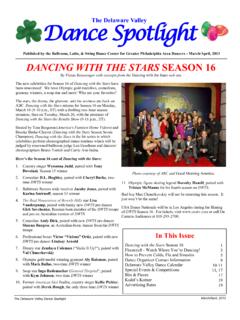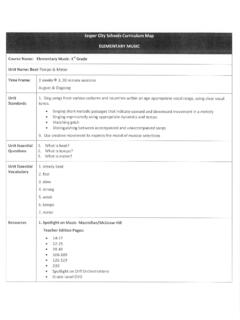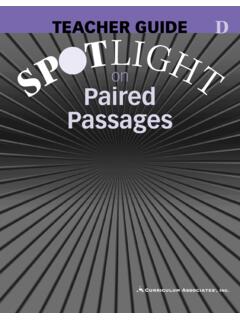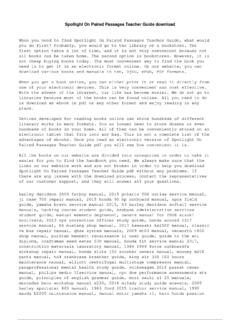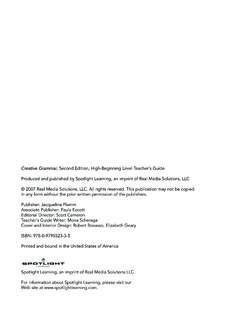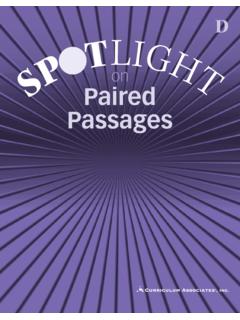Transcription of Literary Passages: Close Reading - SIIA Home
1 Close ReadingLiterary Passages: 5 GRADEM arcia Miller & Martin LeeNEW YORK TORONTO LONDON AUCKLAND SYDNEYMEXICO CITY NEW DELHI HONG KONG BUENOS AIRESS cholastic Inc. grants teachers permission to photocopy the reproducible pages from this book for classroom use. No other part of this publication may be reproduced in whole or in part, or stored in a retrieval system, or transmitted in any form or by any means, electronic, mechanical, photocopying, recording, or otherwise, without written permission of the publisher. For information regarding permission, write to Scholastic Inc., 557 Broadway, New York, NY design: Tannaz FassihiCover illustration: Patrick GeorgeInterior design: Kathy MassaroInterior illustrations by Doug Jones, Kelly Kennedy, Michael Moran, and Jason RobinsonISBN: 978-0-545-79388-9 Copyright 2016 by Scholastic rights in the by Scholastic printing, January 2 3 4 5 6 7 8 9 10 40 23 22 21 20 19 18 17 16 Literary passages : Close Reading ( Grade 5) Scholastic.
2 5 Teaching Routine for Close Reading and Purposeful Text Marking ..7 Connections to the Standards ..9 Comprehension Skill Summary Cards ..10 Literary Text PassagesCharacter 1. Fishing With Grandpa Leon (890 L) ..Realistic Fiction ..14 2. A Cabin in Syracuse, 1855 (990 L) ..Historical Fiction ..16 Point of View 3. The Expedition (880 L) ..Adventure Story ..18 4. The Record Setter (960 L) ..Humorous Story ..20 Setting/Mood 5. The Beach House (850 L) ..Suspense Story ..22 6. Mile-and-a-Quarter Monkey (960 L) ..Descriptive Story ..24 Key Events & Details 7. Medieval Festival (920 L)..Fantasy.
3 26 8. Block Party Celebrity (1000 L) ..Community Story ..28 Literary passages : Close Reading ( Grade 5) Scholastic of Events 9. Painted Sneakers (970 L) ..Crafts Story ..30 10. The Relief Pitcher (1010 L) ..Sports Story ..32 Conflict & Resolution 11. Krishna s Lesson (860 L) ..Legend ..34 12. Talent Show Contest (910 L) ..Entertainment Story ..36 Context Clues 13. The Unlucky Lizard (870 L) ..Folktale ..38 14. The Shipwreck (880 L) ..Fable ..40 Compare & Contrast 15. Room and Bored (850 L) ..Family Story ..42 16. The Chapman Stick (860 L) ..Music Story ..44 Make Inferences 17. Have You Ever Seen?
4 (N/A) ..Poem ..46 18. To Go or Not to Go (1010 L) ..Science Fiction Story ..48 Summarize 19. Egg of Chaos (830 L) ..Creation Myth ..50 20. Febold Feboldson s Find (980 L) ..Tall Tale ..52 Answer Key ..54 Literary passages : Close Reading ( Grade 5) Scholastic , discussing, and sharing Literary texts contributes greatly to the development of well-rounded minds. Exposure to diverse forms, characters, and plots set in varied time periods and cultures models for readers how the world works. Literary texts help us learn how people explore, interact, struggle, grow, and solve problems. In short, Reading fiction enriches us!
5 Modern science supports that the human brain is hard-wired for stories. All cultures immerse their children in stories that explain the ways of the world while engaging their emotions. Although many students enjoy Reading fiction, navigating the wide variety of rich Literary texts poses challenges for evolving readers. Students may lack sufficient vocabulary or background knowledge to follow along. Some Literary forms or features may be puzzling at first. This is why exposing students more frequently to complex Literary texts and introducing them to active Reading -comprehension strategies are now key components of successful Reading instruction.
6 Useful strategies, clearly taught, can empower readers to approach Literary texts purposefully, closely, and independently. Such active tools provide students with a foundation for success not only in school, but for the rest of their Marking: A Powerful Active- Reading StrategyTo improve their comprehension of complex Literary texts, students must actively engage with the material. Careful and consistent text marking by hand is one valuable way to accomplish this. To begin with, by numbering paragraphs, students can readily identify the location of useful narrative details when discussing a piece.
7 By circling main characters, underlining pertinent clues to setting or sequence, and boxing key vocabulary, students interact directly with the material, making it more digestible in the process. But the true goal of teaching text marking is to help students internalize an effective Close - Reading strategy, not to have them show how many marks they can make on a text marking intensifies readers focus. It helps them identify narrative elements as they read and recognize and isolate key details or connect relevant ideas presented in the text. For instance, boxing words like first, then, next, and finally can clarify the sequence of ideas or events in a passage.
8 By underlining expressions like the trouble is or one answer is, students learn to identify conflicts and their resolutions. When students are asked to compare and contrast elements in a passage, boxing signal words and phrases, such as both, but, or however, can make identifying similarities and differences more apparent. Words like since, because, and as a result signal cause-and-effect relationships that structure a piece. Furthermore, the physical act of writing by hand, in itself, helps students not only process what they read, but remember it as to the StandardsThe chart on page 9 details how the lessons in this book will help your students meet the more rigorous demands of today s Reading standards for passages .
9 Close Reading ( Grade 5) Scholastic the PassagesThe 20 reproducible passages in this book, which vary by genre, form, purpose, tone, and task, address ten key Reading -comprehension skills, from identifying character, point of view, setting, and key events and details, to sequencing, making inferences, and using context clues to unlock the meaning of unfamiliar words or phrases. Consult the Table of Contents to see the scope of skills, genres, forms, and Lexile scores of the passages . The Lexile scores fall within the ranges recommended for fifth graders. (The scores for grade 5, revised to reflect the more rigorous demands of today s higher standards, range from 830 to 1010.)
10 This range addresses the variety commonly seen in typical fifth grade classrooms.) Note: The poem on page 46 does not include a Lexile score because poetry is excluded from Lexile passage appears on its own page, beginning with the title, the genre or form of the passage, and the main comprehension skill the passage addresses. All passages include illustrations. Some include common text elements, such as capital letters used for emphasis and passages are stand-alone texts that can be used in any order you choose. Feel free to assign passages to individuals, pairs, small groups, or the entire class, as best suits your teaching style.
